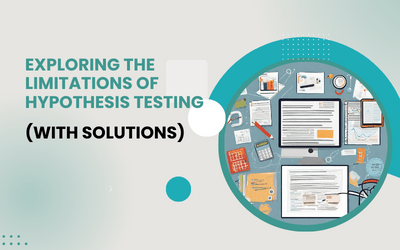
When we’re working on a big research project, like a PhD dissertation, it’s not just about collecting data. We also use something called “hypothesis testing” to make sense of that data. But, there are some important things we need to know about testing the hypothesis and gathering data. There are limits, or boundaries, to what it can tell us. These limitations of the tests of hypotheses often get overlooked, but they’re really important. In this blog, we’re going to take a close look at these limitations of hypothesis testing. We’ll use a simple testing of hypothesis example to help explain. This will help you see how hypothesis testing works and what it can and can’t do. So, let’s dive in and learn more about this important part of doing research!
Testing the hypothesis and gathering data involves a crucial step in research. It’s like detective work where we use data to find answers to important questions. First, we make a guess, called a hypothesis, about what we think might be true. Then, we gather data to see if our guess is correct. But, we must be careful. Sometimes, our guess might not be entirely right, or the data might not be perfect. This is where hypothesis testing comes in. It helps us weigh the evidence and make sure our conclusions are solid. So, in a nutshell, it’s about making sure our ideas are backed up by good, reliable information.
Now, let’s talk about the limitations of null hypothesis testing and also the solutions which will help us to overcome the limitations.
Null Hypothesis Testing can sometimes be like a magnifying glass – it makes small things look big and big things look small. This happens because the size of the group we’re studying, known as the sample size, can greatly influence the results. When we have a very big group, even tiny differences can seem really important. But if our group is very small, big differences might not seem so important.
Imagine trying to explain a complex idea using only a few words. Sometimes, Null Hypothesis Testing does something similar. It gives us a simple ‘yes’ or ‘no’ answer, which can be like trying to capture a whole story in just a sentence. This can be a limitation because it might not tell us the full picture. It doesn’t say how likely or unlikely our result is, or how big of a difference we found.
Instead of just focusing on whether the result is ‘significant’ or not, pay attention to how big the difference or effect is. This helps us understand if it’s actually important in real-world terms. These are like safety nets around our estimates. They give us a range of values that the true result is likely to fall within. This can be more informative than just a single-point estimate.
P-values tell us how likely our result is due to chance. But they don’t tell us how big the effect is. By presenting both the p-value and the effect size, we get a more complete picture. Ask yourself if the difference you found actually matters in real life. Sometimes, even if a result is statistically significant, it might not be practically important.
Understanding the limitations of hypothesis testing and also the limitations of the tests of hypotheses is really important, especially for those working on a big research project like a PhD dissertation. We’ve taken a close look at testing of hypotheses for PhD dissertations that affect how we gather and understand data. By using a real example, we’ve shown how these limits play a big role in research. Knowing about testing of hypothesis and gathering of data helps researchers make sure their conclusions are not just based on numbers, but also make sense in real life. So, as we finish exploring these limits, let’s remember that they’re like a guide, helping us make our research strong and trustworthy.
24x7editing.com helps the PhD researchers to overcome the limitations of hypothesis testing for scholars, which goes beyond proofreading service, by including a more detailed focus on the chapter-wise presentation and formatting contains the complete dissertation, as well as a basic language, grammar, and spelling check. The service is imperative for two reasons – firstly, the need for a thorough revision of the document for language consistency and secondly to ensure that academic/scholarly writing rules, citation rules and formats are complied with. They have a pool of professional PhD dissertation editors in the US, from multiple backgrounds having subject-specific knowledge, which enables them to deliver a perfectly edited, well-structured, and formatted document which eventually overcomes the limitations of the tests of hypotheses with testing of hypothesis examples. Their confidence in their service quality reflects from the perspective that they offer a 100% money-back guarantee for their dissertation editing services in the US. If a client is not satisfied with the editing quality or recommendations made by the dissertation editor, they shall refund the full amount paid without asking any questions.